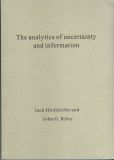用户登陆搜 索 |
查看图书
图书目录:Acknowledgments
Introduction: The economics of uncertainty and information Part I 1 Elements of decision under uncertainty 1.1 The menu of acts 1.2 The probability function 1.2.1 Risk versus uncertainty 1.2.2 "Hard "' versus "'soft "' probabilities 1.3 The consequence function 1.4 The utility function and the Expected -utility Rule 1.4.1 The Expected-utility Rule: informal presentation 1.4.2 The Expected-utility Rule." Axiom of c.omplex gambles 1.5 Risk-aversion 1.6 Utility paradoxes and rationality Exercises and excursions References and selected readings 2 Risk-bearing" the optimum of the individual 2.1 The risk-bearing optimum: basic analysis 2.1.1 Contingent-claims markets 2.1.2 Regimes of asset markets - complete and incomplete 2.1.3 Productive opportunities 2.2 State-dependent utility 2.3 Choosing combinations of mean and standard deviation of income 2.3.1 u, o preferences 2.3.2 Opportunity set and risk-bearing optimum Exercises and excursions References and selected readings 3 Comparative statics of the risk-bearing optimum 3.1 Measures of risk-aversion 3.2 Endowment and price effects 3.2.1 Complete markets 3.2.2 Incomplete markets 3.3 Changes in the distribution of asset payoffs 3.4 Stochastic dominance 3.4.1 Comparison of different consumption prospects *3.4.2 Responding to increased risk Exercises and excursions References and selected readings 4 Market equilibrium under uncertainty 4.1 Market equilibrium in pure exchange 4.1.1 Application to share-cropping 4.1.2 Application to insurance 4.2 Production and exchange 4.2.1 Equilibrium with production ." complete markets *4.2.2 Stockmarket equilibrium *4.2.3 Monopoly power in asset markets 4.3 Asset prices in the mean, standard deviation model Exercises and excursions References and selected readings Part II 5 Int'ormation and informational decisions 5.1 Information - some conceptual distinctions 5.2 Informational decision analysis 5.2.1 The use of evidence to revise beliefs 5.2.2 Revision of optimal action and the worth of information *5.2.3 More informative versus less informative message services 5.2.4 Differences in utility functions and the worth of information 5.2.5 The worth of information ." flexibility versus range of actions 5.3 Multi-person decisions 5.3.1 The use of experts 5.3.2 Group choices Exercises and excursions References and selected readings 6 The economics of emergent public information 6.1 The inter-related equilibria of prior and posterior markets 6.1.1 Complete Contingent Markets 6.1.2 Incomplete regimes of markets 6.2 Speculation and futures trading 6.3 Rational expectations Exercises and excursions References and selected readings 7 Research and invention 7. I The production of information 7.1.1 The scale of research : overinvestment or underinvestment ? 7.1.2 Timing: is there a rush to invent? 7.2 Intended dissemination of information 7.3 Unintended dissemination: the leakage problem 7.3.1 Partial leakage with constant absolute risk-aversion Exercises and excursions References and selected readings 8 Informational asymmetry and contract design 8.1 Hidden actions (" moral hazard ") and contract design 8.2 Hidden knowledge 8.2.1 Adverse selection 8.2.2 Screening *8.2.3 Monopoly price discrimination with hidden knowledge Exercises and excursions References and selected readings 9 Strategic uncertainty and equilibrium concepts 9.1 Nash equilibrium 9.2 Evolutionary equilibrium 9.3 Subgame-perfect equilibrium 9.4 Further refinements 9.5 Games with private information 9.6 Non-cooperative bargaining: a cautionary tale Exercises and excursions References and selected readings 10 The economics of contests 10.1 Contests with full information 10.1.1 Refundable bids 10.1.2 Non-refundable discriminatory contests 10.1.3 Non-refundable non- discriminatory contests 10.2 Contests with private information 10.2.1 Revenue equivalence in identical-belief contests * 10.2.2 Correlated beliefs 10.2.3 Designing an optimal contest Exercises and excursions References and selected readings 1 1 Competition and hidden knowledge 1 1. I Screening 11.1.1 Screening by means of non- productive actions 11.1.2 Screening with productive actions 11.2 Reactive equilibrium 11.3 Signaling Exercises and excursions References and selected readings 12 Long-run relationships and the credibility of threats and promises 12.1 The multi-period Prisoners' Dilemma 12.2 The folk theorem for infinitely repeated games 12.3 The role of chivalry 12.4 Building a reputation Exercises and excursions References and selected readings lndex * Starred sections represent more difficult or specialized materials that can be omitted without significant loss of continuity. |

